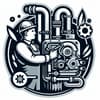Podcast
Questions and Answers
A Pareto chart is a graphical representation of data used to identify the most significant problems or causes based on their _________ or magnitude.
A Pareto chart is a graphical representation of data used to identify the most significant problems or causes based on their _________ or magnitude.
frequency
The Pareto Principle is also known as the _________ rule.
The Pareto Principle is also known as the _________ rule.
80/20
Control charts are statistical tools used to monitor processes over ________.
Control charts are statistical tools used to monitor processes over ________.
time
_______ is a methodology that focuses on process improvement and variation reduction.
_______ is a methodology that focuses on process improvement and variation reduction.
Root cause analysis helps to identify the underlying ________ of a problem.
Root cause analysis helps to identify the underlying ________ of a problem.
______ is a disciplined approach to improving business processes through the elimination of defects and control of variation.
______ is a disciplined approach to improving business processes through the elimination of defects and control of variation.
Quality management tools like the Pareto chart, control charts, Six Sigma, root cause analysis, and ______ are essential components in maintaining and improving the quality of products, services, and processes.
Quality management tools like the Pareto chart, control charts, Six Sigma, root cause analysis, and ______ are essential components in maintaining and improving the quality of products, services, and processes.
______ allow teams to monitor performance trends and make necessary adjustments when deviation from acceptable standards occurs.
______ allow teams to monitor performance trends and make necessary adjustments when deviation from acceptable standards occurs.
Root cause analysis (RCA) is a systematic approach to identifying the underlying reasons behind incidents, nonconformances, or defects. By understanding the root cause(s) of a problem, organizations can address the core issue rather than just treating ______.
Root cause analysis (RCA) is a systematic approach to identifying the underlying reasons behind incidents, nonconformances, or defects. By understanding the root cause(s) of a problem, organizations can address the core issue rather than just treating ______.
Fishbone diagram, also known as an Ishikawa diagram, is a visual tool used to structure and organize information related to the potential causes of a problem. It uses a diagram of the skeleton of a fish, where the head represents the main problem, and the spine represents the primary causes, while branches represent secondary causes. When conducting a fishbone analysis, the team identifies key inputs, processes, equipment, people, and measurements that could influence the outcome, resulting in a more comprehensive assessment of potential ______.
Fishbone diagram, also known as an Ishikawa diagram, is a visual tool used to structure and organize information related to the potential causes of a problem. It uses a diagram of the skeleton of a fish, where the head represents the main problem, and the spine represents the primary causes, while branches represent secondary causes. When conducting a fishbone analysis, the team identifies key inputs, processes, equipment, people, and measurements that could influence the outcome, resulting in a more comprehensive assessment of potential ______.
Flashcards are hidden until you start studying
Study Notes
Quality Management Tools
Quality management refers to the process of maintaining and improving the quality of products, services, and processes through various methodologies and tools designed to enhance customer satisfaction, efficiency, and performance. Several key tools play a crucial role in this process of continuous improvement. These tools include the Pareto chart, control charts, Six Sigma, root cause analysis, and fishbone diagrams. Each tool serves a specific purpose within the broader framework of quality management systems.
Pareto Chart
A Pareto chart is a graphical representation of data used to identify the most significant problems or causes based on their frequency or magnitude. It ranks factors and helps prioritize improvements by focusing on the causes that contribute most to the overall problem. The chart takes its name from Vilfredo Pareto's observation of the unequal distribution of wealth in Italy, which became known as the 80/20 rule or Pareto Principle. In quality management, this principle can help identify the critical few problems affecting the many, allowing teams to tackle the most impactful issues first for maximum benefit.
Control Charts
Control charts are statistical tools used to monitor processes over time, helping to detect trends or shifts that may indicate potential changes in process performance. These charts plot data points over time, along with upper and lower control limits, which represent the expected range of variation within a stable process. Control charts allow teams to monitor performance trends and make necessary adjustments when deviation from acceptable standards occurs. This helps maintain stability and reduce variability in the long run.
Six Sigma
Six Sigma is a disciplined approach to improving business processes through the elimination of defects and control of variation. It targets reduction of errors and waste in production and services by implementing rigorous methodologies such as Define, Measure, Analyze, Improve, and Control (DMAIC). Six Sigma aims to improve efficiency and consistency in processes while enhancing customer satisfaction, all with the goal of achieving near perfection in terms of product and service quality.
Root Cause Analysis
Root cause analysis (RCA) is a systematic approach to identifying the underlying reasons behind incidents, nonconformances, or defects. By understanding the root cause(s) of a problem, organizations can address the core issue rather than just treating symptoms. RCAs typically involve five steps: planning, data collection, analysis, identification, and reporting. Various techniques can be employed during the analysis phase, including 5 Whys, Fault Tree Analysis (FTA), Event Tree Analysis (ETA), and Hazard Operability Studies (HAZOPs).
Fishbone Diagram
Also known as an Ishikawa diagram, a fishbone diagram is a visual tool used to structure and organize information related to the potential causes of a problem. It uses a diagram of the skeleton of a fish, where the head represents the main problem, and the spine represents the primary causes, while branches represent secondary causes. When conducting a fishbone analysis, the team identifies key inputs, processes, equipment, people, and measurements that could influence the outcome, resulting in a more comprehensive assessment of potential causes.
In conclusion, quality management tools like the Pareto chart, control charts, Six Sigma, root cause analysis, and fishbone diagram are essential components in maintaining and improving the quality of products, services, and processes. Each tool serves a unique purpose within the broader framework of quality management systems, helping teams prioritize improvements, monitor performance, target defects and waste, and systematically analyze problems to achieve sustainable excellence. By leveraging these tools effectively, organizations can enhance their operational efficiency, meet customer expectations, and foster continuous improvement.
Studying That Suits You
Use AI to generate personalized quizzes and flashcards to suit your learning preferences.




